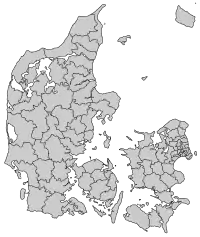Læsø
Læsø ("Isle of Hlér") is the largest island in the North Sea bay of Kattegat, and is located 19 kilometres (12 mi) off the northeast coast of the Jutland Peninsula, the Danish mainland. Læsø is also the name of the municipality (Danish, kommune) on that island. The island is a location mentioned in several instances in Old Norse sources detailing Norse mythology.
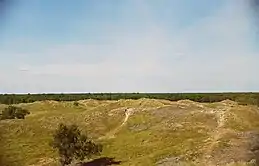 Højsande, Læsø | |
 | |
| Geography | |
|---|---|
| Location | Kattegat |
| Coordinates | 57°15′36″N 11°00′00″E |
| Area | 101 km2 (39 sq mi) |
| Administration | |
Denmark | |
| Region | North Jyland Region |
| Municipality | Læsø Municipality |
| Largest settlement | Byrum (pop. 488) |
| Demographics | |
| Population | 1,793 (2017) |
| Pop. density | 15.74/km2 (40.77/sq mi) |
| Official name | Læso |
| Designated | 2 September 1977 |
| Reference no. | 149[1] |
Name and Norse mythology
- For more information, see Ægir#Hlér,_Læsø,_Lejre,_and_Snow
The modern Danish form of the island's name, læsø, developed from Old Norse Hlésey, meaning 'Hlér's island'.[2] Hlér (Old Norse 'sea'), also known as Ægir (also Old Norse 'sea'), is a jötunn and personification of the sea in Norse mythology whose nine daughters personify waves. Simlarly, the Danish city of Lejre may also derive from Hlér.[3]
In the Poetic Edda poem Hárbarðsljóð, the god Thor comments that it was on Hlésey that he was attacked by (and so fought) "berserk women" or "brides of berserks" who had bewitched all of the men on the island. Thor details that, upon beaching his ship, the women battered it, threatened him with iron clubs and chased his servant, Þjálfi:
- Benjamin Thorpe translation:
- She-wolves they were, and scarcely women.
- They crushed my ship, which with props I had secured,
- with iron clubs threatened me, and drove away Thiâlfi.
- What meanwhile didst thou, Harbard?[4]
- Henry Adams Bellows translation:
- She-wolves they were like, and women little;
- My ship, which well I had trimmed, did they shake;
- With clubs of iron they threatened, and Thjalfi they drove off.
- What, Harbarth, didst thou the while?[5]
These "women" are personified waves and/or jötnar. The island is also a setting in the poems Helgakviða Hundingsbana II and Oddrúnargrátr, the saga Örvar-Odds saga, in two skaldic kennings, and the aforementioned (see etymology section above) Prose Edda book Skáldskaparmál.[6]
The Municipality of Læsø
The municipality is in Region Nordjylland in northern Denmark. The municipality, Denmark's least populous, covers Læsø and neighboring small islands for a total area of 114 square kilometres (44 sq mi), and has a total population of 1,793 as of 1 January 2017.[7][8] The population has been steadily declining, and according to Danmarks Statistik (Statistikbanken.dk) was:
| Year | Inhabitants |
|---|---|
| 2006 | 2091 |
| 2007 | 2056 |
| 2008 | 2003 |
| 2009 | 1993 |
| 2010 | 1969 |
| 2011 | 1949 |
| 2012 | 1897 |
| 2013 | 1839 |
| 2014 | 1808 |
| 2015 | 1795 |
| 2016 | 1817 |
| 2017 | 1793 |
Its mayor is Karsten Nielsen as of 1 January 2018. He is a member of the Danish People's Party political party.
The main town and the site of its municipal council is Byrum.
Because Læsø is an island and lies in the Kattegat, its neighboring municipality, Frederikshavn on the Jutland peninsula, is separated by water, the Læsø Rende, from the island municipality.
Ferry service connects Frederikshavn on the Jutland peninsula to the municipality at the town of Vesterø Havn while Østerby Havn is the island's fishing harbour.
Læsø Municipality was not merged with any adjacent municipality under the municipal reform of 2007, as it agreed to enter into a "municipal cooperation agreement" with Frederikshavn Municipality.[9]
Municipal council
Læsø's municipal council consists of 9 members, elected every four years.
Below are the municipal councils elected since the Municipal Reform of 2007.
| Election | Party | Total seats |
Turnout | Elected mayor | |||||||||
|---|---|---|---|---|---|---|---|---|---|---|---|---|---|
| A | D | F | H | L | O | V | |||||||
| 2005 | 2 | 2 | 2 | 3 | 9 | 78.5% | Olav Juul Gaarn Larsen (V) | ||||||
| 2009 | 2 | 1 | 1 | 4 | 2 | 81.8% | Thomas W. Olsen (L) | ||||||
| 2013 | 2 | 1 | 1 | 2 | 1 | 2 | 83.7% | Tobias B. Johansen (L) | |||||
| 2017 | 1 | 2 | 2 | 4 | 82.3% | Karsten Nielsen (O) | |||||||
| Data from Kmdvalg.dk 2005, 2009, 2013 and 2017 | |||||||||||||
Nature and protections
Læsø has an outstanding botanical interest. The nature-types on and around Læsø includes open water, extensive mudflats, sand banks, heathland, islets and areas of arable land. It houses Denmarks largest tidal saltmarsh outside the Wadden Sea but the decline in grazing animals has led to a gradual vegetational succession. Invasive species are colonizing the site, especially Japanese Rose, and scrub clearance has been implemented to re-establish the former pastures open heathland. Seals like the Harbor seal are breeding around Læsø and the whole area is an internationally important area for wintering, molting and staging waterbirds. Therefore, a Ramsar protection was put into force in 1977 (number 149) and today it encompass 66,548 ha.[10]
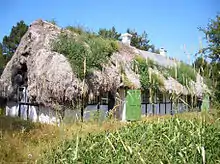
Climate, industry and wildlife
Together with Anholt, Læsø belongs to the Danish "desert belt"; during the summer months there is so little rain that streams and ponds partly dry up.
In the Middle Ages, the island was known for its salt industry. The ground water can reach over 15 percent salt, and this was naturally concentrated in flat salt meadows during the hot dry summers. The final concentration, carried out in hundreds of salt kilns, consumed large amounts of wood. Eventually the island became deforested, sandstorms buried villages, and salt extraction was banned. Since the end of the 1980s it has been resumed on a small scale as an archaeological experiment and a tourist attraction.
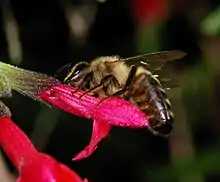
Læsø is home to the bee subspecies European dark bee. The species is protected by Danish law which prohibits the import of other species to the island. The law has not been enforced and today normal bees and brown bees are both used for the production of honey. The island has been split in two parts for bee management, one for each species.
Læsø is home to unique styles of Danish traditional music. Most of it is not played any more but has been preserved through intense documentation and research in the 1980s and 1990s.
The HVDC powerline Kontiskan crosses Læsø as overhead line. On Læsø, there is also a 160 metres tall radio relay mast.
Notable residents
- Gustav S. Christensen (1929 in Laesoe – 2007 in Canada) an academic mathematician and engineer.
- Mogens Bay Esbensen (born 1930) a prominent Danish born chef and author has lived there since 1992 [11]
- Per Kirkeby (1938–2018) a Danish painter, poet, film maker and sculptor owned a house and studio on the island
Gallery
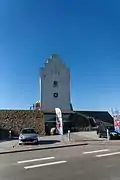 Læsø kur
Læsø kur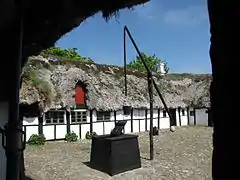 Museumsgården
Museumsgården.jpg.webp) Læsø
Læsø Fannemandsfærgen
Fannemandsfærgen
See also
Notes
- "Læso". Ramsar Sites Information Service. Retrieved 25 April 2018.
- McKinnell (2005:110) and Faulkes (1995:59).
- Simek 1996, p. 151.
- Thorpe (1866:76).
- Bellows (1923:92).
- McKinell (2005:110).
- "Læsø Kommune", Den store Danske. (in Danish) Retrieved 28 June 2010.
- "Danmarks Statistik." Retrieved 11 February 2015.
- https://www.retsinformation.dk/Forms/R0710.aspx?id=10080
- The Annotated Ramsar List: Denmark Archived 2014-02-22 at the Wayback Machine Ramsar, 05.08.2013
- "HugeDomains.com - StephenDownes.com is for sale (Stephen Downes)". stephendownes.com. Retrieved 12 April 2018. Cite uses generic title (help)
References
- Bellows, Henry Adams (Trans.) (1923). The Poetic Edda. New York: The American-Scandinavian Foundation.
- Faulkes, Anthony (Trans.) (1995). Edda. Everyman. ISBN 0-460-87616-3
- McKinnell, John (2005). Meeting the Other in Norse Myth in Legends. D.S. Brewer. ISBN 1-84384-042-1
- Simek, Rudolf (1996). Dictionary of Northern Mythology. D.S. Brewer. ISBN 978-0-85991-513-7.
- Thorpe, Benjamin (Trans.) (1907). The Elder Edda of Saemund Sigfusson. Norrœna Society.
External links
| Wikimedia Commons has media related to Læsø. |
- Official website
- Municipal statistics: NetBorger Kommunefakta, delivered from KMD aka Kommunedata (Municipal Data)
- Municipal mergers and neighbors: Eniro new municipalities map
